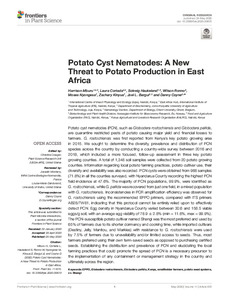| dc.contributor.author | Mburu, H. |
| dc.contributor.author | Cortada-Gonzalez, L. |
| dc.contributor.author | Haukeland, S. |
| dc.contributor.author | Ronno, W. |
| dc.contributor.author | Nyongesa, M. |
| dc.contributor.author | Kinyua, Z. |
| dc.contributor.author | Bargul, J.L. |
| dc.contributor.author | Coyne, D. |
| dc.date.accessioned | 2022-08-19T09:02:12Z |
| dc.date.available | 2022-08-19T09:02:12Z |
| dc.date.issued | 2020 |
| dc.identifier.citation | Mburu, H., Cortada, L., Haukeland, S., Ronno, W., Nyongesa, M., Kinyua, Z., ... & Coyne, D. (2020). Potato cyst nematodes: a new threat to potato production in East Africa. Frontiers in Plant Science, 11(670), 1-13. |
| dc.identifier.issn | 1664-462X |
| dc.identifier.uri | https://hdl.handle.net/20.500.12478/7664 |
| dc.description.abstract | Potato cyst nematodes (PCN), such as Globodera rostochiensis and Globodera pallida, are quarantine restricted pests of potato causing major yield and financial losses to farmers. G. rostochiensis was first reported from Kenya’s key potato growing area in 2015. We sought to determine the diversity, prevalence and distribution of PCN species across the country by conducting a country-wide survey between 2016 and 2018, which included a more focused, follow-up assessment in three key potato growing counties. A total of 1,348 soil samples were collected from 20 potato growing counties. Information regarding local potato farming practices, potato cultivar use, their diversity and availability was also recorded. PCN cysts were obtained from 968 samples (71.8%) in all the counties surveyed, with Nyandarua County recording the highest PCN field-incidence at 47.6%. The majority of PCN populations, 99.9%, were identified as G. rostochiensis, while G. pallida was recovered from just one field, in a mixed population with G. rostochiensis. Inconsistencies in PCR amplification efficiency was observed for G. rostochiensis using the recommended EPPO primers, compared with ITS primers AB28/TW81, indicating that this protocol cannot be entirely relied upon to effectively detect PCN. Egg density in Nyandarua County varied between 30.6 and 158.5 viable eggs/g soil, with an average egg viability of 78.9 ± 2.8% (min = 11.6%, max = 99.9%). The PCN-susceptible potato cultivar named Shangi was the most preferred and used by 65% of farmers due to its shorter dormancy and cooking time, while imported cultivars (Destiny, Jelly, Manitou, and Markies) with resistance to G. rostochiensis were used by 7.5% of farmers due to unavailability and/or limited access to seeds. Thus, most farmers preferred using their own farm-saved seeds as opposed to purchasing certified seeds. Establishing the distribution and prevalence of PCN and elucidating the local farming practices that could promote the spread of PCN is a necessary precursor to the implementation of any containment or management strategy in the country and ultimately across the region. |
| dc.description.sponsorship | Federal Ministry for Economic Cooperation and Development, Germany |
| dc.description.sponsorship | North Carolina State University |
| dc.format.extent | 1-13 |
| dc.language.iso | en |
| dc.subject | Globodera Rostochiensis |
| dc.subject | Kenya |
| dc.subject | Smallholders |
| dc.subject | Farmers |
| dc.subject | Potatoes |
| dc.title | Potato cyst nematodes: a new threat to potato production in east Africa |
| dc.type | Journal Article |
| cg.contributor.crp | Roots, Tubers and Bananas |
| cg.contributor.affiliation | International Centre of Insect Physiology and Ecology |
| cg.contributor.affiliation | International Institute of Tropical Agriculture |
| cg.contributor.affiliation | Jomo Kenyatta University of Agriculture and Technology |
| cg.contributor.affiliation | Ghent University |
| cg.contributor.affiliation | Norwegian Institute for Bioeconomy Research |
| cg.contributor.affiliation | Food and Agriculture Organization of the United Nations |
| cg.contributor.affiliation | Kenya Agricultural and Livestock Research Organisation |
| cg.coverage.region | Africa |
| cg.coverage.region | East Africa |
| cg.coverage.country | Kenya |
| cg.coverage.hub | Eastern Africa Hub |
| cg.researchtheme | Biotech and Plant Breeding |
| cg.researchtheme | Natural Resource Management |
| cg.identifier.bibtexciteid | MBURU:2020 |
| cg.isijournal | ISI Journal |
| cg.authorship.types | CGIAR and developing country institute |
| cg.iitasubject | Agronomy |
| cg.iitasubject | Crop Systems |
| cg.iitasubject | Disease Control |
| cg.iitasubject | Food Security |
| cg.iitasubject | Plant Breeding |
| cg.iitasubject | Plant Diseases |
| cg.iitasubject | Plant Production |
| cg.journal | Frontiers in Plant Science |
| cg.notes | Published online: 25 May 2020 |
| cg.accessibilitystatus | Open Access |
| cg.reviewstatus | Peer Review |
| cg.usagerightslicense | Creative Commons Attribution 4.0 (CC BY 0.0) |
| cg.targetaudience | Scientists |
| cg.identifier.doi | https://dx.doi.org/10.3389/fpls.2020.00670 |
| cg.iitaauthor.identifier | LAURA CORTADA: 0000-0002-5953-3798 |
| cg.iitaauthor.identifier | Daniel Coyne: 0000-0002-2030-6328 |
| cg.futureupdate.required | No |
| cg.identifier.issue | 670 |
| cg.identifier.volume | 11 |

